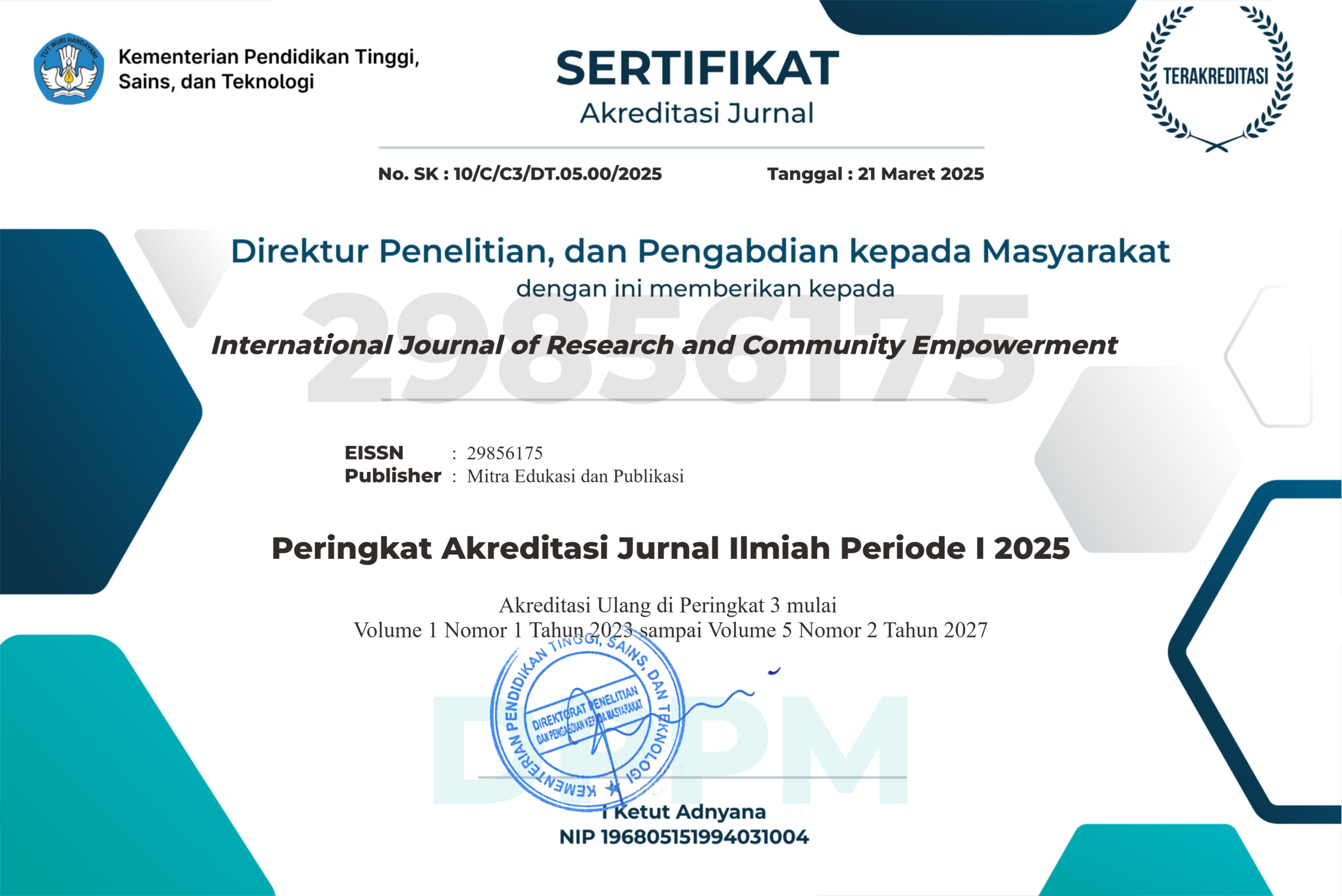Ethnophysics Analysis of Traditional Patil Lele Game: Unveiling Physics Concepts in Local Wisdom
DOI:
https://doi.org/10.58706/ijorce.v2n2.p40-47Keywords:
Patil Lele, Game Technique, Ethnophysics, Physics Local WisdomAbstract
Local wisdom is integral to a community's cultural identity, encapsulating knowledge, values, and practices passed down through generations. The traditional game of Patil Lele, rich in cultural significance, also serves as a valuable educational tool for exploring fundamental physics concepts. This study aims to analyze the physics principles inherent in the Patil Lele game and identify optimal techniques for achieving maximum throwing distance. The research used a quantitative descriptive method; Data were collected through interviews and observations and supported by a thorough literature review. The findings reveal that the game embodies key physics concepts, including parabolic motion, Newton's laws, the moment of force, momentum, and impulse. Moreover, three effective techniques for enhancing throwing distance were identified. This research underscores the importance of applying physics concepts to enhance traditional games, enriching educational value and preserving cultural heritage.
References
Alfisyah, A. and Rini, J. (2021). Studi Etnomatematika dalam Permainan Tradisional Patok Lele pada Komunitas Traditional Games Returns Pekalongan. Prosiding Seminar Nasional Tadris Matematika (SANTIKA), 94–112. Retrieved from: http://proceeding.iainpekalongan.ac.id/index.php/santika/article/view/325.
Amalia, S. (2021). Penerapan Strategi Permainan Tradisional Gatrik pada Materi Operasi Hitung Perkalian Peserta Didik Kelas II UPT SD Negeri 263 Gresik. Doctoral Ddissertation. Gresik: Universitas Muhammadiyah Gresik.
Arifi, M.F., Lesmono, A.D. and Handayani, R.D. (2021). Analisis Konsep Fisika Pada Penggunaan Alat Pertanian Cangkul Oleh Petani Sebagai Bahan Pembelajaran Fisika. Jurnal Pembelajaran Fisika, 10(3), 121-129. DOI: https://doi.org/10.19184/jpf.v10i3.25563.
Ariza, H., & Tamrin, M.I. (2021). Pendidikan Agama Islam Berbasis Kearifan Lokal (Benteng di Era Globalisasi). Jurnal Kajian dan Pengembangan Umat, 4(2), 44-60. DOI: https://doi.org/10.31869/jkpu.v4i2.2926.
Asra, A., Festiyed, F., Mufit, F., & Asrizal, A. (2021). Pembelajaran Fisika Mengintegrasikan Etnosains Permainan Tradisional. Konstan-Jurnal Fisika dan Pendidikan Fisika, 6(2), 66-73. DOI: https://doi.org/10.20414/konstan.v6i2.67.
Burhan, Z. and Hidayat, T. (2023). Pengaruh Permainan Tradisional Mpa’a Gelu Terhadap Motivasi Belajar Siswa pada Pelajaran PJOK di SD Negeri 1 Dompu’. Jurnal Pendidikan Jasmani, Kesehatan, dan Rekreasi, 1(1), 8–15. DOI: https://doi.org/10.59584/jurnalpjkr.v1i1.17.
Dani, R., Jufrida, J., Basuki, F. R., & Handayani, F. (2022). Pengembangan Buku Pengayaan Fisika Berkonteks Etnosains pada Permainan Patok Lele dan Gobak Sodor. Physics and Science Education Journal (PSEJ), 2, 101–109. DOI: https://doi.org/10.30631/psej.v2i2.1543.
Erman & Suyatno. (2022). Pembelajaran Sains Berbasis Kearifan Lokal. Surabaya: Penerbit JDS.
Faiz, A., & Soleh, B. (2021). Implementasi Pendidikan Karakter Berbasis Kearifan Lokal. JINoP (Jurnal Inovasi Pembelajaran), 7(1), 68-77. DOI: https://doi.org/10.22219/jinop.v7i1.14250.
Fauziah, A., & Darvina, Y. (2019). Analisis Miskonsepsi Peserta Didik dalam Memahami Materi Gerak Lurus dan Gerak Parabola pada Kelas X SMAN 1 Padang. Pillar of Physics Education, 12(1), 73-80. DOI: http://dx.doi.org/10.24036/4813171074.
Handayani D.P., Jumadi, W.I., and Kuswanto H. (2019). Development of Comic Integrated Student Worksheet to Improve Critical Thinking Ability in Microscope Material. Journal of Physics Conference Series, 1233, 012069. DOI: https://doi.org/10.1088/1742- 6596/1233/1/012069.
Handayani, F. (2022). Pengembangan Buku Pengayaan Fisika pada Permainan Tradisional Patok Lele dan Gobak Sodor Berkonteks Etnosains. Doctoral dissertation. Jambi: Universitas Jambi.
Iswatiningsih, D. (2019). Penguatan Pendidikan Karakter Berbasis Nilai-Nilai Kearifan Lokal di Sekolah. Satwika: Kajian Ilmu Budaya dan Perubahan Sosial, 3(2), 155-164. DOI: https://doi.org/10.22219/satwika.v3i2.10244 .
Jamalludin, J., Handayani, R.D., & Nuraini L. (2021). The Development of Interactive Learning Media of Parabolic Motion Lesson Materials with Patil Lele Traditional Games. Berkala Ilmiah Pendidikan Fisika, 9(2), 126-134. DOI: http://dx.doi.org/10.20527/bipf.v9i2.10399.
Maghfiroh, A., & Kuswanto, H. (2021, March). Development of Physics Comics Through Android-Assisted Benthik Game with Discovery Learning Model on Parabolic Motion. In 7th International Conference on Research, Implementation, and Education of Mathematics and Sciences (ICRIEMS 2020) (pp. 446-450). Atlantis Press. DOI: https://doi.org/10.2991/assehr.k.210305.065.
Mughny, A.A. (2016). Rancang Bangun Kit Percobaan Konservasi Momentum Berbasis Mikrokontroler. Jurnal Inovasi Fisika Indonesia (IFI), 5(3), 9-14. Retrieved from: https://ejournal.unesa.ac.id/index.php/inovasi-fisika-indonesia/article/view/21279.
Mukti, H., Suastra, I. W., & Aryana, I. B. P. (2022). Integrasi Etnosains dalam Pembelajaran IPA. JPGI (Jurnal Penelitian Guru Indonesia), 7(2), 356-362. DOI: https://doi.org/10.29210/022525jpgi0005.
Niman, E. M. (2019). Kearifan Lokal dan Upaya Pelestarian Lingkungan Alam. Jurnal Pendidikan dan Kebudayaan Missio, 11(1), 91-106. DOI: https://doi.org/10.36928/jpkm.v11i1.139.
Ningtias, S. W. (2021). Analisis Permainan Tradisional Daerah Kabupaten Sarolangun. Journal Evaluation in Education (JEE), 2(4), 125-133. DOI: https://doi.org/10.37251/jee.v3i2.241.
Nurmasyitah, N., Virnalita, V., & Lubis, N.A. (2022). Kajian Etnofisika Konsep Gerak Parabola pada Permainan Tradisional Aceh “Geulengkue Teu Peu Poe”. Jurnal Pendidikan Fisika, 10(2), 245-258. DOI: https://doi.org/10.24127/jpf.v10i2.5217.
Priadana, M. S., & Sunarsi, D. (2021). Metode Penelitian Kuantitatif. Banten: Pascal Books.
Putra, H.S.A. (2021). Ethnoscience a Bridge to Back to Nature. E3S Web of Conferences, 249, 01002. DOI: https://doi.org/10.1051/e3sconf/202124901002.
Rohmawati, D., Ulfa, I.M., & Fajar, D.M. (2019). Penggunaan Metode Permainan Tradisional Patil Lele dalam Memahami Konsep Gerak Parabola pada Pembelajaran Kinematika. LP3DI Press. pp. 147–160. Available at: http://digilib.uinkhas.ac.id/1708/2/Buku IPA-159-172.pdf.
Rumiati, R., Handayani, R.D., & Mahardika, I.K. (2021). Analisis Konsep Fisika Energi Mekanik pada Permainan Tradisional Egrang sebagai Bahan Pembelajaran Fisika. Jurnal Pendidikan Fisika, 9(2), 131. DOI: https://doi.org/10.24127/jpf.v9i2.3570.
Sholihah, L., Bekti Haryo Putri, N. and Dina Handayani, R. (2023). Analisis Konsep Momen Gaya, Momen Inersia, dan Keseimbangan Benda Tegar pada Rumah Adat Osing Banyuwangi. Jurnal Inovasi Pendidikan Sains dan Terapan (INTERN), 2(2), 76–84. DOI: https://doi.org/10.58466/intern.v2i2.1192.
Wulansari, N.I. and Admoko, S. (2021). Eksplorasi Konsep Fisika pada Tari Dhadak Merak Reog Ponorogo. PENDIPA Journal of Science Education, 5(2), 163–172. DOI: https://doi.org/10.33369/pendipa.5.2.163-172.
Downloads
Additional Files
Published
How to Cite
Issue
Section
License
Copyright (c) 2024 Azizatul Nur Rohmah, Nur Afni Agustinaningrum, Nur Lailatur Rohmah, Nadya Mazayu Nur Sabrina, Satya Cantika Agustinur, Khalid Issa Khalifa Alemgadmi, Utama Alan Deta

This work is licensed under a Creative Commons Attribution-NonCommercial 4.0 International License.







